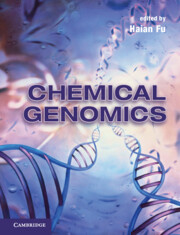Book contents
- Frontmatter
- Contents
- Contributors
- Preface
- Section one Overviews
- Section two Molecules for Chemical Genomics
- Section Three Basics of High-Throughput Screening
- Chapter 8 Essentials for High-Throughput Screening Operations
- Chapter 9 High-Content Analysis and Screening: Basics, Instrumentation, and Applications
- Chapter 10 Phenotypic Screens with Model Organisms
- Chapter 11 Screening Informatics and Cheminformatics
- Section Four Chemical Genomics Assays and Screens
- Section five Chemical Genomics and Medicine
- Index
- References
Chapter 10 - Phenotypic Screens with Model Organisms
from Section Three - Basics of High-Throughput Screening
Published online by Cambridge University Press: 05 June 2012
- Frontmatter
- Contents
- Contributors
- Preface
- Section one Overviews
- Section two Molecules for Chemical Genomics
- Section Three Basics of High-Throughput Screening
- Chapter 8 Essentials for High-Throughput Screening Operations
- Chapter 9 High-Content Analysis and Screening: Basics, Instrumentation, and Applications
- Chapter 10 Phenotypic Screens with Model Organisms
- Chapter 11 Screening Informatics and Cheminformatics
- Section Four Chemical Genomics Assays and Screens
- Section five Chemical Genomics and Medicine
- Index
- References
Summary
Chemical genetics (see this book and [1]) for an extensive review) offers a complementary approach to loss-of-function mutations in the analysis of complex, multicomponent biological processes. Large-scale mutagenesis screens using genetic model systems have been used very successfully for many years in identifying genes involved in developmental and physiological events. However, such screens are expensive and time consuming. In addition, with respect to later development and organogenesis, these screens can be limited in scope. During embryonic development, many patterning and signaling systems are used multiple times [2–4]. Thus, if an embryo is disrupted at an early time point because of a mutation, later events using the same pathway become difficult to study. Such mutagenesis screens therefore do not allow for the finer temporal control of protein function. The ability to have temporal control over compound addition and thus the modulation of protein function provides a more focused approach to phenotypic assays. This also means that chemical genomic screens are applicable to maternal proteins, which many traditional mutagenesis screens are not, significantly extending the opportunity to identify key endogenous players in biological processes.
In this chapter, we focus on some of the multicellular organisms commonly used for chemical genomic screens, including plants, worm (Caenorhabditis elegans), fruit fly (Drosophila melanogaster), fish (zebrafish), and frog (Xenopus). Table 10.1 shows some of the general advantages and disadvantages of commonly used model organisms. With respect to chemical genetics, which requires high-throughput screening (HTS), organisms producing large numbers of embryos are essential, so chick and mouse are not suitable for such screens. However, because of the conservation of protein sequence and especially protein structure between species, small molecules identified in screens in one species can be tested in another species, with the reasonable expectation that the compound will interact with a similar protein. Thus, molecules identified in screens can be tested in higher organisms such as mouse and chick as well as in other systems such as cell-based assays using human cells. In the case of plants, compounds identified in Arabidopsis spp. can then be tested in other species such as crops. Another advantage is that, in many cases, compounds that are toxic will have been screened out before testing in higher organisms.
- Type
- Chapter
- Information
- Chemical Genomics , pp. 121 - 136Publisher: Cambridge University PressPrint publication year: 2012
References
- 3
- Cited by

